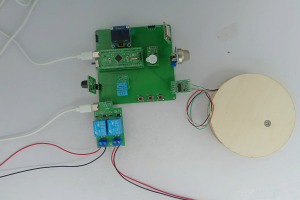设计说明书
总字数:15000+
针对传统猫砂盆需要人工清理、监控不足等问题,设计了一种基于STM32F103C8T6单片机的智能猫砂盆控制系统。该系统集成了HX711、热释电传感器等器件,实现了猫砂余量的自动检测与提醒、猫进入与离开的智能识别、氨气浓度的实时监测与报警、环境温湿度的显示、用户自定义阈值设置、手动与远程翻砂消毒控制等功能。当猫砂余量不足时,系统会进行声光报警提醒主人添加猫砂;猫离开后,系统会自动延时翻砂并开启消毒灯,过程中检测到猫则返回待机状态;氨气浓度超标时,也会触发报警。系统还支持通过OLED实时显示测量数据,以及通过WIFI模块将数据发送至手机端,实现远程监控与操作。测试结果表明,该系统设计方案合理,控制方法有效,能显著提高猫砂盆的智能化水平,减少人工干预,提升用户体验,具有较高的实用价值和应用前景。
关键词:猫砂盆;传感器;STM32F103C8T6;WiFi;OLED显示屏
A smart cat litter box control system based on STM32F103C8T6 microcontroller has been designed to address issues such as manual cleaning and insufficient monitoring of traditional cat litter boxes. The system integrates HX711, pyroelectric sensors and other devices, realizing automatic detection and reminder of cat litter balance, intelligent recognition of cat entry and exit, real-time monitoring and alarm of ammonia concentration, display of environmental temperature and humidity, user-defined threshold setting, manual and remote sand turning and disinfection control and other functions. When the remaining cat litter is insufficient, the system will sound and light an alarm to remind the owner to add cat litter; After the cat leaves, the system will automatically delay sanding and turn on the disinfection light. If a cat is detected during the process, it will return to standby mode; When the ammonia concentration exceeds the standard, an alarm will also be triggered. The system also supports real-time display of measurement data through OLED and sending data to the mobile phone through WIFI module for remote monitoring and operation. The test results show that the system design scheme is reasonable, the control method is effective, and it can significantly improve the intelligence level of the litter box, reduce manual intervention, enhance user experience, and has high practical value and application prospects.
Keywords:cat litter box; Sensors; STM32F103C8T6; WiFi; OLED display screen
目 录
1 绪论
1.1研究背景及意义
1.2国内外研究现状
1.2.1国外研究现状
1.2.2国内研究现状
1.3论文的主要内容及结构
2 系统需求分析及总体方案设计
2.1系统功能需求分析
2.2系统总体设计
2.3主要模块方案选择
2.3.1主控模块方案选择
2.3.2温湿度检测模块方案选择
2.3.3显示模块方案选择
2.3.4无线通信模块方案选择
3 硬件设计
3.1主控模块电路设计
3.1.1 主控芯片简介
3.1.2 单片机最小系统
3.2称重模块电路设计
3.3热释电检测模块电路设计
3.4氨气检测模块电路设计
3.5温湿度检测模块电路设计
3.6显示模块电路设计
3.7按键模块电路设计
3.8声光报警模块电路设计
3.9继电器模块电路设计
3.10WiFi模块电路设计
4 系统程序设计
4.1Keil5编程软件介绍
4.2系统主流程设计
4.3温湿度子程序设计
4.4称重子程序设计
4.5显示模子程序设计
4.6Wi-Fi子程序设计
4.7阿里云物联网平台技术
4.7.1阿里云平台简介
4.7.2 阿里云调试步骤
5 实物制作与功能测试
5.1实物制作
5.2称重测控检测实物测试
5.3热释电检测实物测试
5.4氨气测控实物测试
5.5温湿度检测实物测试
5.6WiFi模块实物测试
6 结论
参考文献
致谢
附录A 原理图
附录B PCB
购买后可查看具体内容!

